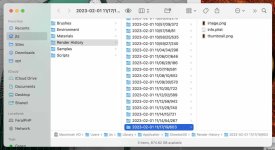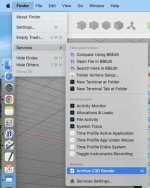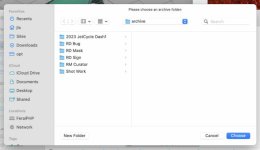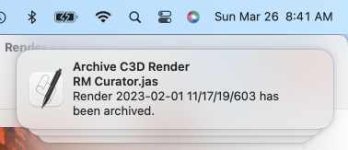Helmut
0
Render Manager / Render History
* I prefer to have just a sparse list of current work-in-progress jobs in the window of the render manager.
* As a result I delete jobs which are completed. However, wanting to maintain an archive of (often time consuming) renders which I may wish to revisit and improve, I move some of these from the rubbish bin into sets of archival folders. These get dumped onto an external SBB drive. If required, I can move the folder holding a specific stack into the render history and access the data - deleted recently or long ago - in the render manager.
* This procedure is a bit awkward as documents in the render history are not assigned useful titles. It is necessary to check the info.plist to determine the .jas source of a stack of .png images or to open one of the images (generally hundreds) to "guess" the associated .jas.
* I am aware that the render manager is just a list of pointers but I see no reason to have dozens of obsolete jobs / images cluttering up this list. Renaming folders in the render history breaks the link, so this is a bit frustrating.
 Can somebody suggest an intuitive and - preferably - simplish alternative which they have devised to support their own work-flow?
Can somebody suggest an intuitive and - preferably - simplish alternative which they have devised to support their own work-flow?
* after moving the stack from an external USB on line


* as saved on a SSD USB external drive

* I prefer to have just a sparse list of current work-in-progress jobs in the window of the render manager.
* As a result I delete jobs which are completed. However, wanting to maintain an archive of (often time consuming) renders which I may wish to revisit and improve, I move some of these from the rubbish bin into sets of archival folders. These get dumped onto an external SBB drive. If required, I can move the folder holding a specific stack into the render history and access the data - deleted recently or long ago - in the render manager.
* This procedure is a bit awkward as documents in the render history are not assigned useful titles. It is necessary to check the info.plist to determine the .jas source of a stack of .png images or to open one of the images (generally hundreds) to "guess" the associated .jas.
* I am aware that the render manager is just a list of pointers but I see no reason to have dozens of obsolete jobs / images cluttering up this list. Renaming folders in the render history breaks the link, so this is a bit frustrating.
* after moving the stack from an external USB on line
* as saved on a SSD USB external drive






